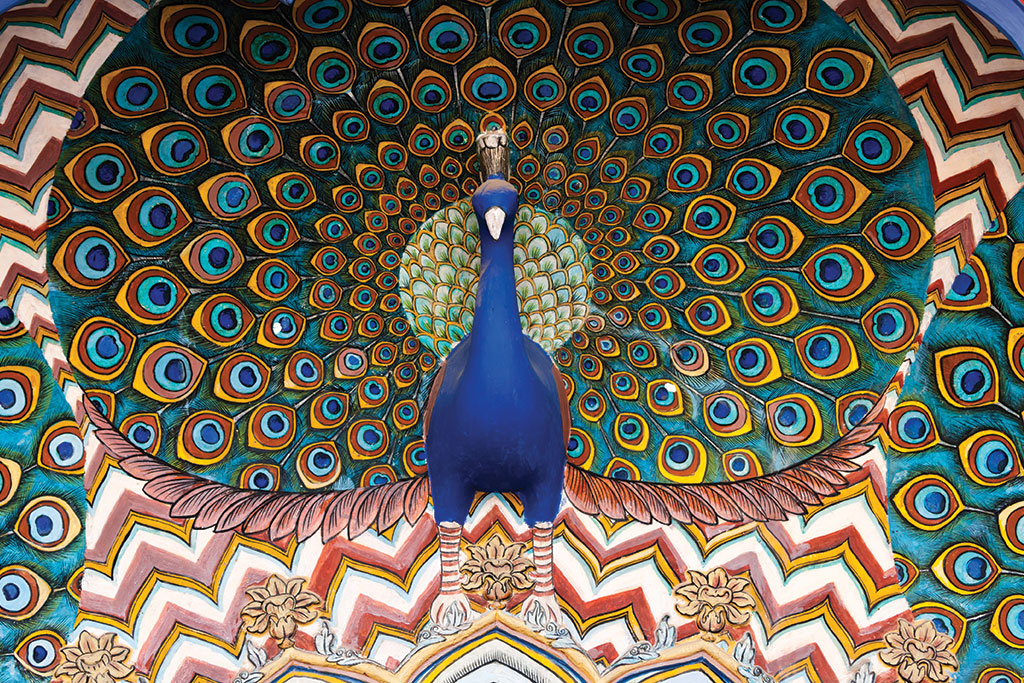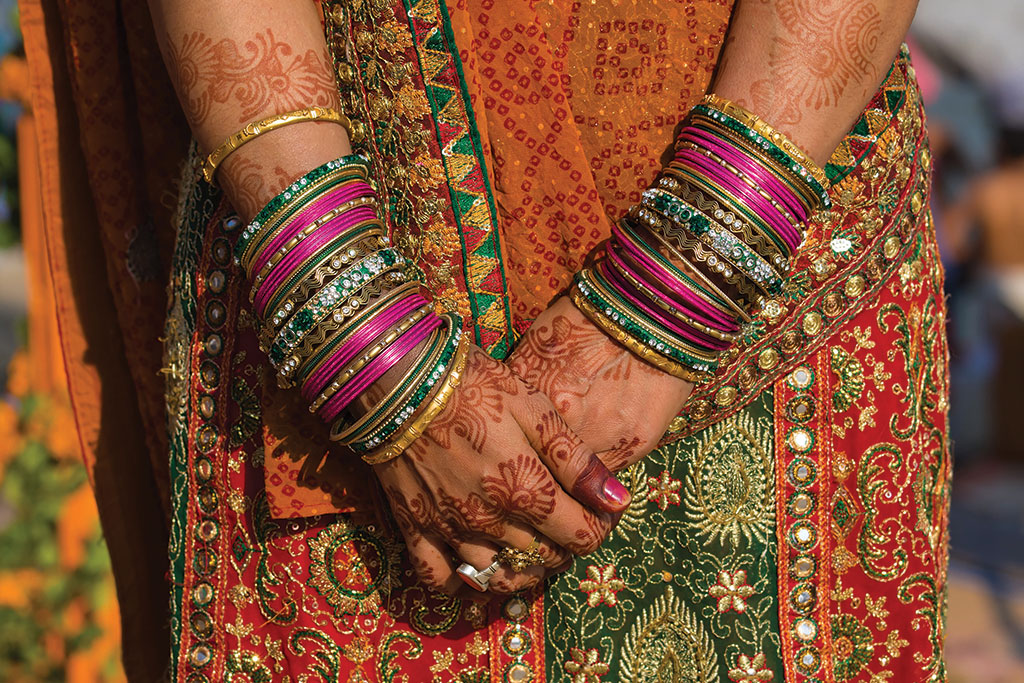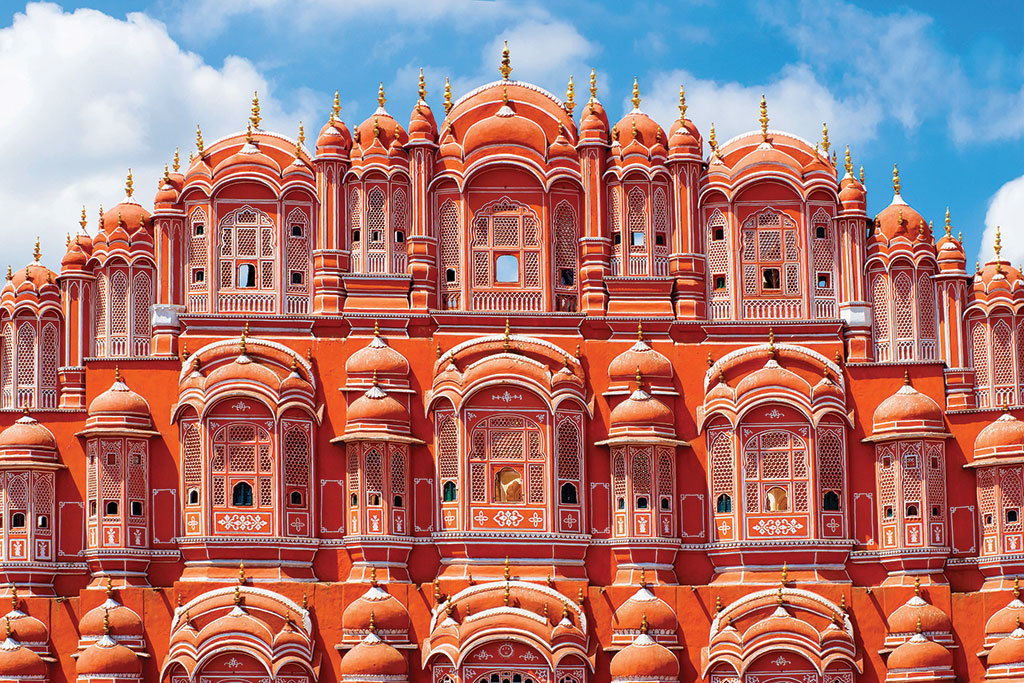We spent that evening in the modest private home of Rashmi Marwah, a middle-aged, middle-class homemaker who, since her grown daughter married and moved out, has tapped an entrepreneurial spirit and began hosting small gatherings of foreign tourists for casual dinners, at which the guests are invited to help prepare one of the dishes.
John and I toasted cumin seeds in a pan of oil, releasing the earthy, slightly anise-tinged aroma so typical of northern Indian cuisine. Mixing it with a dash of chili pepper, mouth-puckering mango powder, and floral, citrusy coriander powder, we’d created a distinctive masala, or spice mix, to which we added cubed, boiled potatoes, sautéing and coating them in the flavored oil. With a bright sprinkle of cilantro (the leaves of the coriander plant) on top, we had a warming, vibrant jeera aloo.
A far cry from the Cordon Bleu, cooking with Rashmi was as more about sharing the ambiance of a Delhi family home than a lesson in technique. She and her husband Anil fussed over us, serving just-fried samosas and a mild lamb curry as we sat around their living room coffee table on overstuffed couches, asking questions about daily life and turning down offers of Coca Cola, the assumed American choice of beverage.

Lake Pichola in Udaipur
Luxe India took an already remarkable evening a step further when company vice president, Amit Aggarwal, arrived with a special guest, Anjali Gopalan, executive director of the Naz Foundation (www.nazindia.org), a Delhi-based non-profit focused on HIV/AIDS and sexual rights.
“The whole matter of counseling men who have sex with men is so different here than in the US,” said Gopali, who studied and worked in New York for a decade prior to returning to India and starting Naz. “Because Indian family tradition is so strong, many men still want to marry women and have children.”


Jaipur Man Wearing a dhoti
Homosexual sex and gay identity are still very different to most Indians, she explained. “The whole idea that men can form meaningful relationships with each other is difficult to help people understand.”
Nonetheless, between 2001 and 2009, Gopali and Naz successfully spear-headed efforts to decriminalize homosexuality in India. While the Indian Supreme Court overturned that ruling in 2013, public dialogue on the subject has remained active and there is growing support for another court reversal.
While India is not yet as safe a place for its LGBT natives as many Western countries, its larger cities have hosted gay pride parades and lower courts have made some surprisingly liberal rulings protecting same-sex couples from harassment. Discussions of transgender rights actually seem quite prominent, due in part explained Gopali, to the ancient Hindu tradition of hijira, or third-sex people. Filling out our customs forms on arrival in the country, we could check a box for male, female, or other.
Luxe India’s openness and resourcefulness in introducing LGBT travelers to local community leaders like Gopali should serve as a model for other tour operators. Far more than “gay-friendly” lip service, this was an exemplary effort in engagement.
After Delhi’s gritty juxtaposition of India past and present, the lake city of Udaipur offered a mind-clearing change of pace. A fairytale iteration of India, the city, founded in the 16th century, offers an abundance of elegant vistas, its chain of man-made lakes reflecting the magnificent palaces that rise on its banks and islands.
Arriving via an early morning flight from Delhi on SpiceJet, a stylish Indian airline that compares favorably to Virgin America, we began our day with a leisurely tour of the City Palace, on the eastern shore of Lake Pichola. Actually multiple palaces built by successive generations of ruling families, the adjoining buildings harmonize beautifully, forming a marble and granite labyrinth of intimate spaces: small galleries, sitting rooms, public ceremonial chambers, and charming garden terraces.
Extraordinarily detailed miniature paintings, marble inlay work, murals, silver vessels, and colored glass mosaics greeted us at every turn as we navigated the complex’s narrow corridors and staircases. The density of ornate embellishment in relatively modest-sized rooms sometimes made us feel almost drenched in riches. But then, through an arched win- dow, we’d take in a placid view of the lake, the visual equivalent of catch- ing one’s breath, and resubmerge ourselves in the palace’s sea of treasures.


Peacock gatel decoration of the city palace, Jaipur
Perhaps the most extravagant display of dynastic wealth here (the City Palace complex is still partly owned and occupied by the members of an extended family descended from the region’s historic royalty) is the Crystal Gallery. In 1877, Maharana Sajjian Singh ordered the gallery’s glittering contents from a British manufacturer. The collection comprises thousands of pieces of tableware, chandeliers, vases, and decanters, as well as full-sized furniture (couches, dining tables, and a bed) made of shimmering transparent glass.
Not only did the Maharana die before his trove was delivered, but the boxes in which it was delivered were warehoused, unopened, for over 100 years. Never used privately, they ultimately went straight to exhibition. Admission fees to the gallery help his progeny pay to keep up their portions of the palace.
That afternoon, we took lunch on a lakeshore terrace just outside the palace grounds, savoring freshly-baked naan, tandoori chicken, and a spicy sauté of tomato, onion, and okra. Okra is surprisingly popular in India. Called bhindi in Hindi and known in local English as “lady fingers” it was offered at many meals throughout our trip.
Afterward, we plied the waters of Pichola in a traditional wooden boat, gliding past the Lake Palace (www.tajhotels.in), a glistening white edifice, with a foundation spreading over the equivalent of four acres. This castle seems to have adopted the entire lake as its moat. The building’s outer walls rise at 90 ̊ from the water, and it was featured on film as the lair of James Bond villainess Octopussy. The one-time royal abode is now a Taj hotel.
Next, we docked at the tea garden of Jag Mandir (www.hrhhotels.com), an island guarded by a herd of stately stone-carved elephants. So was this one, we wondered, a palace or a hotel?
A palace, as it turned out this time. The very question: “Hotel or palace?” points to one of the great sybaritic thrills of Indian tourism. Perhaps no other country in the world offers such graciously indulgent places to spend the night.


Hands of a Woman in Delhi
Our guide Jassi explained that the high caliber of the Indian hospitality industry is not only the result of rigorous training by companies like Oberoi, but is also tied to a traditional Hindu ethos that “the guest is God,” be it in a home or elsewhere. The sense of welcome and the natural, unaffected friendliness extended by the staff members at each hotel we stayed at was extraordinary.
Our quarters that evening were at the Oberoi Udaivilas (www.oberoihotels.com), consistently ranked among the world’s top hotels. Set in an oasis of 50 acres, 20 of which were formerly royal hunting grounds and now serve as a wildlife preserve, the Udaivilas’ 87 rooms are situated along open-air corridors. These sun-shaded paths traverse tiered gardens punctuated by gazebos, fountains, topiary, two elegantly tiled swimming pools, and a giant gilded sundial.
Common areas and dining rooms were situated in a series of domed chambers, their ceilings elaborately painted with renderings of the sky at different times of day.
Walking over the manicured lawns in the waning afternoon sun, John and I found ourselves on an elevated platform overlooking an adjacent hillside where two deer clacked antlers in a bit of playful rivalry and a pair of enormous brown boars wandered by.
Headed back toward our room, where a private outdoor terrace await- ed, a handful of resident peacocks strutted past. One stopped, cocked his crown, and fanned his kaleidoscopic tailfeathers, as if to insist that nature could still out-design even the most opulent hotelier.


Hawa Mahal palace (Palace of the Winds) in Jaipur
Another morning, another hour’s flight. Next on our lightning itinerary was Jaipur, the Pink City. Founded in 1726, many of the Jaipur’s oldest palaces and temples were built with sandstone, which has been deemed pink post facto. But had Jaipur truly been nicknamed for the natural color of these buildings, it would perhaps be known as the Baby Aspirin or Salmon City. The true story owes a bit more to colonialism.
The city’s sobriquet actually emerged during the era of British rule. In 1876, prior to a visit to the city by the Prince of Wales, the regional Maharaja, in a dramatic gesture intended both to extend a warm welcome and curry favor in trade, ordered all of the city’s buildings to be painted pink, a color that traditionally symbolizes hospitality in India.
An authorized spectrum ranging from pale rose to deep brick remains Jaipur’s hallmark today, certainly a success in building the tourist trade. My own perception is that the relatively uniform architectural color scheme has calming effect. In this city of three million, abuzz with activity, the consistent palette creates a soothing illusion of orderliness, distinctly different from Delhi.


